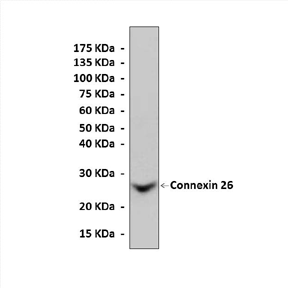Anti-Connexin 26: Rabbit Connexin 26 Antibody |
 |
BACKGROUND Gap channels (also known as gap junctions) are specalized cell-cell contacts between almost all eukaryotic cells that serve a critical role in facilitating physiological function as well as in maintaining tissue homeostasis. Generally, gap channels allow the passive diffusion of molecules up to 1 kDa which includes nutrients, small metabolites (e.g. glucose), ions (K+, Ca2+) and second messengers (IP3, cAMP and cGMP). Gap channels allow electrical and biochemical coupling between cells and in excitable tissues, such as neurons and the heart, enables the generation of synchronized and rapid responses.1
Gap junctions are formed by the assembly of Connexin (Cx) proteins. The type and degree of Cx expression in each tissue is cell-, age-, and stage-dependent, and such regulation is tightly controlled. Cx26 is one member of a family of related gap-junction channel-forming proteins, each of which is commonly named from its molecular weight (Cx26, Cx30 etc.). The genes for 20 different Connexin proteins are present in the human genome. Six Connexins oligomerise intracellularly to form the gap junction channel unit of an individual cell, a Connexon, which is trafficked to the plasma membrane. There, the Connexons of one cell align symmetrically with those of its neighbor to create continuous aqueous pores that functionally couple the adjacent cells. Connexons aggregate in the plane of the plasma membrane to form a gap junction plaque. Different Connexin proteins differ in the size and charge characteristics of the channel and in their regulatory properties. Most cells that form gap junctions express more than one Connexin isotype. There is thus potentially a wide variety of possible gap junction compositions, each with different physiological characteristics. All the Connexins in an individual Connexon maybe of the same type (homomeric) or heteromeric Connexons may be formed by oligomerization between different Connexins. The Connexon composition each side of the junction maybe the same (homotypic junctions) or heterotypic junctions can be formed where the Connexons of one cell are different in composition from those of its neighbor. Within the same junction plaque, there may be separate homomeric, homotypic regions of differing composition, or a cell may ferry different Connexins to separate locations. Gap channels are regulated through post-translational modifications of the C'-terminal cytoplasmic tail and phosphorylation modulates assembly and their physiological properties. They are continuously synthesized and degraded, allowing tissues to rapidly adapt to changing environmental conditions. Connexins play a key role in many physiological processes including cardiac and smooth muscle contraction, regulation of neuronal excitability, epithelial electrolyte transport and keratinocyte differentiation.2
Gap junctions are formed by the assembly of Connexin (Cx) proteins. The type and degree of Cx expression in each tissue is cell-, age-, and stage-dependent, and such regulation is tightly controlled. Cx26 is one member of a family of related gap-junction channel-forming proteins, each of which is commonly named from its molecular weight (Cx26, Cx30 etc.). The genes for 20 different Connexin proteins are present in the human genome. Six Connexins oligomerise intracellularly to form the gap junction channel unit of an individual cell, a Connexon, which is trafficked to the plasma membrane. There, the Connexons of one cell align symmetrically with those of its neighbor to create continuous aqueous pores that functionally couple the adjacent cells. Connexons aggregate in the plane of the plasma membrane to form a gap junction plaque. Different Connexin proteins differ in the size and charge characteristics of the channel and in their regulatory properties. Most cells that form gap junctions express more than one Connexin isotype. There is thus potentially a wide variety of possible gap junction compositions, each with different physiological characteristics. All the Connexins in an individual Connexon maybe of the same type (homomeric) or heteromeric Connexons may be formed by oligomerization between different Connexins. The Connexon composition each side of the junction maybe the same (homotypic junctions) or heterotypic junctions can be formed where the Connexons of one cell are different in composition from those of its neighbor. Within the same junction plaque, there may be separate homomeric, homotypic regions of differing composition, or a cell may ferry different Connexins to separate locations. Gap channels are regulated through post-translational modifications of the C'-terminal cytoplasmic tail and phosphorylation modulates assembly and their physiological properties. They are continuously synthesized and degraded, allowing tissues to rapidly adapt to changing environmental conditions. Connexins play a key role in many physiological processes including cardiac and smooth muscle contraction, regulation of neuronal excitability, epithelial electrolyte transport and keratinocyte differentiation.2
In the inner ear cx26 is widely expressed throughout non-sensory epithelial and connective tissue cells, and is commonly co-expressed with cx30. The clinical consequence of certain mutations in the cx26 gene is exclusively hearing loss (non-syndromic deafness), whereas with other mutations the deafness is part of a syndrome. In particular, mutations responsible for dominantly-inherited hearing loss can also underlie various skin disorders.3
REFERENCES
1. Beyer, E.C. et al: J. Membrane Biol. 116:187-94, 1990
2. Willecke K. et al: Biol. Chem. 383:725-37, 2002
3. Kemperman, M.H. et al: J. R. Soc. Med. 95: 171–7, 2002
2. Willecke K. et al: Biol. Chem. 383:725-37, 2002
3. Kemperman, M.H. et al: J. R. Soc. Med. 95: 171–7, 2002
Products are for research use only. They are not intended for human, animal, or diagnostic applications.
Параметры
Cat.No.: | CA1025 |
Antigen: | Short peptide from human CX26 sequence. |
Isotype: | Rabbit IgG |
Species & predicted species cross- reactivity ( ): | Human, Rat |
Applications & Suggested starting dilutions:* | WB 1:1000 IP n/d IHC 1:200 ICC n/d FACS n/d |
Predicted Molecular Weight of protein: | 26 kDa |
Specificity/Sensitivity: | Detects endogenous levels of CX26 proteins without cross-reactivity with other related proteins. |
Storage: | Store at -20°C, 4°C for frequent use. Avoid repeated freeze-thaw cycles. |
*Optimal working dilutions must be determined by end user.
Документы
Информация представлена исключительно в ознакомительных целях и ни при каких условиях не является публичной офертой








